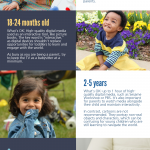Digital connectivity can be a powerful and positive tool for increased communication and intimacy between romantic partners. However, when one partner resorts to digital means to hurt the other, it can have harmful consequences. To better understand how, and how often, digital technology is used by domestic abusers to victimize their partners, we teamed up with the Data & Society research institute and talked to over 3,000 Americans ages 16 and older about their experiences. Here’s what we learned: What does digital domestic abuse look like? Digital domestic abuse experiences span the relatively benign—albeit likely irritating—to the possibly damaging, and include: revenge porn, sexually harassing a partner online, controlling a partner’s social media accounts (e.g., demanding social … [Read more...]
4 Ways Tech Can Help Improve your Health this Spring
We live in a digital world. This reality comes with both benefits and potential drawbacks. On the one hand, we love our access to endless information and entertainment. On the other, we may worry that we’re spending too much time looking at a screen. We may feel guilty when we spend several hours surfing the web, or when we hit ‘watch next episode’ on Netflix for the fourth (or fifth) time in a row... We also shame big technology users: People who play video games are depicted as zombies. We say, “Go outside! Get your eyes off your phone and do something active! Step away from the computer and improve your health!” But do these two areas of our lives, health and tech, have to be mutually exclusive? Say it with me: “NO!” Internet and cell phone-based health programs give us a … [Read more...]
Infographic: Guidelines for Kids & Screen Time
For families with infants and toddlers, this past Christmas may have included dolls, building blocks, and even – reflective of the times – toy smart phones. With the widespread popularity of smart phones and other devices that enhance our daily communication, it's no wonder that kids are also interacting with these technologies at younger and younger ages. You might know that for a long time, the American Academy of Pediatrics (AAP) suggested that children under 2 years of age should not be exposed to any digital devices (no “screen time”) [1]. As a reflection of the greater integration of technology in our lives today, AAP recently reviewed and updated their guidelines. Take a look and see what they are suggesting for children at each developmental stage. Let us know what you … [Read more...]
Teens & Stalking-Like Behaviors
The who and how of stalking among teens. The word “stalker” often conjures up a mental image reminiscent of a bad guy on a Law and Order: Special Victims Unit episode. Stalkers are usually imagined to be adult, male, and more often than not, doing creepy things to someone ‘in person’. But does this match reality? What if the stalker is a teen boy sitting behind a computer screen? Or a teen girl installing a tracking device on her partner’s cell phone? With the emergence of new technologies, and their swift adoption among teens, it’s important to not only consider that adolescents could be engaging in stalker-like behaviors, but also that it could be happening through digital means. Our Growing up with Media study looked at how often 14-21 year olds across America engage in … [Read more...]
Having the Conversation: Birth Control and LGB+ Teens
How to talk to lesbian and bisexual teens about contraception. When we talk about teen pregnancy, many of us may assume that we’re only referring to straight / heterosexual girls. It might surprise you to learn that lesbian and bisexual teens are actually between two and four times more likely to get pregnant than straight girls [1][2]. The reasons are complicated: some sexual minority girls feel like they have to ‘prove’ they’re straight. Others may not find sex education to be helpful because it doesn’t speak to issues they care about. It’s also true that one’s sexual identity and one’s behavior don’t always match up – particularly in adolescence when it is normal to experiment sexually. The pregnancy statistics make it clear that we need to talk to lesbian and bisexual teens … [Read more...]
Stresses & Risks for Transgender Teens
What social stresses might transgender youth face? With the recent mandate for schools to make bathrooms transgender-inclusive [1], and the revelations from Caitlyn Jenner [2], public discussions about people who are transgender have exponentially increased. That doesn’t necessarily mean that all parents of transgender teens are feeling better equipped to talk to their teens about what it means to be transgender or about the challenges that transgender youth can face. Parents make a clear and resounding difference. Transgender youth who have supportive parents do better emotionally – they have better mental health and are generally happier than their unsupported peers [3,4]. So first, just to make sure we’re all clear on what we’re talking about: Gender identity is one’s knowing of … [Read more...]
STI testing: What are teens concerned about?
1 in 2 new cases of STIs occur among young people. How can we change this? Sores? Blisters? Pus oozing from a genital area? Most of us don’t need Google to know that sexually transmitted diseases (STI) can be physically uncomfortable – and really yucky-feeling – to have. This discomfort is mirrored in how many of us feel about talking about STIs with teens. We need to get over this discomfort though, because half of all new cases of STIs occur among 15- to 24-year-olds [1]. We need to move beyond our discomfort and start talking to young people to help them get and stay healthy. I know it’s a difficult discussion, so here are 3 concrete things that you can talk to your teens about: Many teens don’t think they are at risk for STIs The most common reason that youth have never … [Read more...]
Is Sex in the Media Related to Sexual Behavior Among Teens?
How do teens exposed to a lot versus a little sexual media differ? Gone are the days when Lucy and Desi of “I Love Lucy” slept in separate beds. Instead, television shows containing nudity and sexual scenes, such as “Empire”, “Scandal”, or “How to Get Away with Murder,” have become more commonplace. Perhaps it’s not surprising, then, to hear that the amount of sexual content in the media has increased in the 21st century.[1] In our Growing up with Media study, we found that most youth (47%) are exposed to a LOT of sexual content – they said that many, almost all, or all of at least one type of media they consume depict sexual situations like people kissing, fondling each other, and having sex. Conversely, very few – less than one in ten (8%) – report low exposure to sexual … [Read more...]
Three Things Parents Do About Online Safety: Then & Now
Two research surveys ask parents what they do to keep their kids safe online. The Internet landscape has changed a lot over the past several years. Throughout this transformation, the concern of Internet safety has persisted. Given how much the Internet has changed, we wonder if parents’ views on their kids’ online safety have also changed. To address this question, we decided to look at two research studies: Here, at the Center for Innovative Public Health Research, we conducted a national, longitudinal online survey, called Growing up with Media. The first wave of this longitudinal survey began in 2006 and has since run 6 more waves. At Pew Research Center, the national online Teen Relationship study was recently conducted between late 2014 to early 2015. Part of the study’s goal … [Read more...]
How Teen Dating Violence Differs Between Boys and Girls
An infographic, based on a recent paper, examines TDV by sex. Teen dating violence (TDV), sometimes called adolescent dating abuse, is unfortunately common among adolescents. In a recently published paper, we found that as many as 1 in 3 adolescents are involved with TDV as both victim and perpetrator. This finding suggests that adolescents experience TDV in complicated ways and learning healthy communication can be beneficial for both sexes. To learn more about how TDV differs between boys and girls, check out our new infographic: This infographic is based on our publication: Ybarra ML, Espelage DL, Langhinrichsen-Rohling J, Korchmaros JD, boyd d. Lifetime prevalence rates and overlap of physical, psychological, and sexual dating abuse perpetration and victimization in a … [Read more...]










